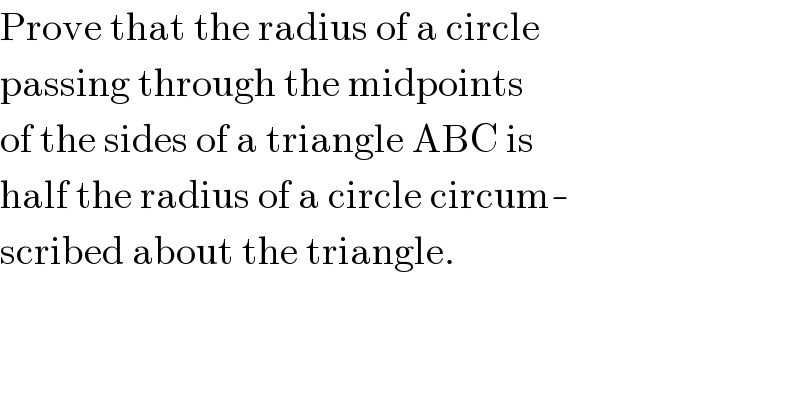
Question Number 19610 by ajfour last updated on 13/Aug/17

$$\mathrm{Prove}\:\mathrm{that}\:\mathrm{the}\:\mathrm{radius}\:\mathrm{of}\:\mathrm{a}\:\mathrm{circle} \\ $$$$\mathrm{passing}\:\mathrm{through}\:\mathrm{the}\:\mathrm{midpoints} \\ $$$$\mathrm{of}\:\mathrm{the}\:\mathrm{sides}\:\mathrm{of}\:\mathrm{a}\:\mathrm{triangle}\:\mathrm{ABC}\:\mathrm{is} \\ $$$$\mathrm{half}\:\mathrm{the}\:\mathrm{radius}\:\mathrm{of}\:\mathrm{a}\:\mathrm{circle}\:\mathrm{circum}- \\ $$$$\mathrm{scribed}\:\mathrm{about}\:\mathrm{the}\:\mathrm{triangle}. \\ $$
Commented by ajfour last updated on 13/Aug/17

Commented by ajfour last updated on 13/Aug/17
![Let B(0,0) ; A(2b,2c) ; C(2a,0) R^2 =h^2 +k^2 ....(1) =(2a−h)^2 +k^2 ...(2) =(h−2b)^2 +(2c−k)^2 ...(3) from (1) and (2): h=a and from (1) and (3): (a−2b)^2 +(2c−k)^2 =a^2 +k^2 ⇒ 4b^2 −4ab=(2k−2c)(2c) or k=c−((b(a−b))/c) hence R^2 =a^2 +[((b^2 +c^2 −ab)/c)]^2 r^2 =(x_0 −a)^2 +y_0 ^2 ...(i) =(x_0 −b)^2 +(y_0 −c)^2 ....(ii) =(x_0 −a−b)^2 +(y_0 −c)^2 ...(iii) using (ii) and (iii) ⇒ x_0 −a−b=b−x_0 or x_0 =b+(a/2) ; Also using (i) and (ii): r^2 =(b+(a/2)−a)^2 +y_0 ^2 =(b+(a/2)−b)^2 +(y_0 −c)^2 ⇒ c(2y_0 −c)=(a^2 /4)−(b−(a/2))^2 ⇒ c(2y_0 −c)=ab−b^2 ⇒ y_0 =(c/2)+((b(a−b))/(2c)) ⇒ (y_0 −c)^2 =[((b(a−b))/(2c))−(c/2)]^2 using (ii): r^2 =(a^2 /4)+[((ab−b^2 −c^2 )/(2c))]^2 ⇒ 4r^2 =a^2 +[((b^2 +c^2 −ab)/c)]^2 =R^2 ⇒ r=(R/2) .](Q19621.png)
$$\mathrm{Let}\:\mathrm{B}\left(\mathrm{0},\mathrm{0}\right)\:\:;\:\:\mathrm{A}\left(\mathrm{2b},\mathrm{2c}\right)\:;\:\:\mathrm{C}\left(\mathrm{2a},\mathrm{0}\right) \\ $$$$\mathrm{R}^{\mathrm{2}} =\mathrm{h}^{\mathrm{2}} +\mathrm{k}^{\mathrm{2}} \:\:\:\:\:\:\:\:\:\:\:\:\:\:\:\:\:\:\:\:\:\:\:\:....\left(\mathrm{1}\right) \\ $$$$\:\:\:\:\:\:=\left(\mathrm{2a}−\mathrm{h}\right)^{\mathrm{2}} +\mathrm{k}^{\mathrm{2}} \:\:\:\:\:\:\:\:\:\:\:\:...\left(\mathrm{2}\right) \\ $$$$\:\:\:\:\:\:=\left(\mathrm{h}−\mathrm{2b}\right)^{\mathrm{2}} +\left(\mathrm{2c}−\mathrm{k}\right)^{\mathrm{2}} \:\:...\left(\mathrm{3}\right) \\ $$$$\mathrm{from}\:\left(\mathrm{1}\right)\:\mathrm{and}\:\left(\mathrm{2}\right):\: \\ $$$$\:\:\:\:\mathrm{h}=\mathrm{a}\:\:\mathrm{and}\:\:\mathrm{from}\:\:\left(\mathrm{1}\right)\:\mathrm{and}\:\left(\mathrm{3}\right): \\ $$$$\:\:\:\left(\mathrm{a}−\mathrm{2b}\right)^{\mathrm{2}} +\left(\mathrm{2c}−\mathrm{k}\right)^{\mathrm{2}} =\mathrm{a}^{\mathrm{2}} +\mathrm{k}^{\mathrm{2}} \\ $$$$\Rightarrow\:\:\:\:\mathrm{4b}^{\mathrm{2}} −\mathrm{4ab}=\left(\mathrm{2k}−\mathrm{2c}\right)\left(\mathrm{2c}\right) \\ $$$$\mathrm{or}\:\:\:\:\mathrm{k}=\mathrm{c}−\frac{\mathrm{b}\left(\mathrm{a}−\mathrm{b}\right)}{\mathrm{c}} \\ $$$$\mathrm{hence}\:\:\mathrm{R}^{\mathrm{2}} =\mathrm{a}^{\mathrm{2}} +\left[\frac{\mathrm{b}^{\mathrm{2}} +\mathrm{c}^{\mathrm{2}} −\mathrm{ab}}{\mathrm{c}}\right]^{\mathrm{2}} \\ $$$$\:\:\mathrm{r}^{\mathrm{2}} =\left(\mathrm{x}_{\mathrm{0}} −\mathrm{a}\right)^{\mathrm{2}} +\mathrm{y}_{\mathrm{0}} ^{\mathrm{2}} \:\:\:\:\:\:\:\:\:\:...\left(\mathrm{i}\right) \\ $$$$\:\:\:\:\:\:=\left(\mathrm{x}_{\mathrm{0}} −\mathrm{b}\right)^{\mathrm{2}} +\left(\mathrm{y}_{\mathrm{0}} −\mathrm{c}\right)^{\mathrm{2}} \:\:\:\:\:....\left(\mathrm{ii}\right) \\ $$$$\:\:\:\:\:\:=\left(\mathrm{x}_{\mathrm{0}} −\mathrm{a}−\mathrm{b}\right)^{\mathrm{2}} +\left(\mathrm{y}_{\mathrm{0}} −\mathrm{c}\right)^{\mathrm{2}} \:\:...\left(\mathrm{iii}\right) \\ $$$$\mathrm{using}\:\left(\mathrm{ii}\right)\:\mathrm{and}\:\left(\mathrm{iii}\right) \\ $$$$\Rightarrow\:\:\:\mathrm{x}_{\mathrm{0}} −\mathrm{a}−\mathrm{b}=\mathrm{b}−\mathrm{x}_{\mathrm{0}} \\ $$$$\mathrm{or}\:\:\:\mathrm{x}_{\mathrm{0}} =\mathrm{b}+\frac{\mathrm{a}}{\mathrm{2}}\:; \\ $$$$\mathrm{Also}\:\:\mathrm{using}\:\left(\mathrm{i}\right)\:\mathrm{and}\:\left(\mathrm{ii}\right): \\ $$$$\:\:\:\mathrm{r}^{\mathrm{2}} =\left(\mathrm{b}+\frac{\mathrm{a}}{\mathrm{2}}−\mathrm{a}\right)^{\mathrm{2}} +\mathrm{y}_{\mathrm{0}} ^{\mathrm{2}} =\left(\mathrm{b}+\frac{\mathrm{a}}{\mathrm{2}}−\mathrm{b}\right)^{\mathrm{2}} +\left(\mathrm{y}_{\mathrm{0}} −\mathrm{c}\right)^{\mathrm{2}} \\ $$$$\Rightarrow\:\:\mathrm{c}\left(\mathrm{2y}_{\mathrm{0}} −\mathrm{c}\right)=\frac{\mathrm{a}^{\mathrm{2}} }{\mathrm{4}}−\left(\mathrm{b}−\frac{\mathrm{a}}{\mathrm{2}}\right)^{\mathrm{2}} \\ $$$$\Rightarrow\:\:\mathrm{c}\left(\mathrm{2y}_{\mathrm{0}} −\mathrm{c}\right)=\mathrm{ab}−\mathrm{b}^{\mathrm{2}} \\ $$$$\Rightarrow\:\:\mathrm{y}_{\mathrm{0}} =\frac{\mathrm{c}}{\mathrm{2}}+\frac{\mathrm{b}\left(\mathrm{a}−\mathrm{b}\right)}{\mathrm{2c}} \\ $$$$\Rightarrow\:\:\left(\mathrm{y}_{\mathrm{0}} −\mathrm{c}\right)^{\mathrm{2}} =\left[\frac{\mathrm{b}\left(\mathrm{a}−\mathrm{b}\right)}{\mathrm{2c}}−\frac{\mathrm{c}}{\mathrm{2}}\right]^{\mathrm{2}} \\ $$$$\mathrm{using}\:\left(\mathrm{ii}\right): \\ $$$$\mathrm{r}^{\mathrm{2}} =\frac{\mathrm{a}^{\mathrm{2}} }{\mathrm{4}}+\left[\frac{\mathrm{ab}−\mathrm{b}^{\mathrm{2}} −\mathrm{c}^{\mathrm{2}} }{\mathrm{2c}}\right]^{\mathrm{2}} \\ $$$$\Rightarrow\:\:\mathrm{4r}^{\mathrm{2}} =\mathrm{a}^{\mathrm{2}} +\left[\frac{\mathrm{b}^{\mathrm{2}} +\mathrm{c}^{\mathrm{2}} −\mathrm{ab}}{\mathrm{c}}\right]^{\mathrm{2}} =\mathrm{R}^{\mathrm{2}} \: \\ $$$$\Rightarrow\:\:\:\:\:\:\boldsymbol{\mathrm{r}}=\frac{\boldsymbol{\mathrm{R}}}{\mathrm{2}}\:. \\ $$
Answered by Tinkutara last updated on 13/Aug/17

$$\mathrm{Let}\:\mathrm{circumradius}\:\mathrm{of}\:\mathrm{original}\:\mathrm{triangle}\:\mathrm{is} \\ $$$${R}\:=\:\frac{{a}_{\mathrm{1}} {b}_{\mathrm{1}} {c}_{\mathrm{1}} }{\mathrm{4}\Delta_{\mathrm{1}} } \\ $$$$\mathrm{New}\:\mathrm{sides}\:\mathrm{are}\:\frac{{a}_{\mathrm{1}} }{\mathrm{2}},\:\frac{{b}_{\mathrm{1}} }{\mathrm{2}}\:\mathrm{and}\:\frac{{c}_{\mathrm{1}} }{\mathrm{2}}\:\mathrm{and}\:\Delta_{\mathrm{2}} \\ $$$$=\:\frac{\Delta_{\mathrm{1}} }{\mathrm{4}} \\ $$$$\mathrm{So}\:{R}'\:=\:\frac{\frac{{a}_{\mathrm{1}} {b}_{\mathrm{1}} {c}_{\mathrm{1}} }{\mathrm{8}}}{\mathrm{4}\frac{\Delta_{\mathrm{1}} }{\mathrm{4}}}\:=\:\frac{\mathrm{1}}{\mathrm{2}}\left(\frac{{a}_{\mathrm{1}} {b}_{\mathrm{1}} {c}_{\mathrm{1}} }{\mathrm{4}\Delta_{\mathrm{1}} }\right)\:=\:\frac{{R}}{\mathrm{2}} \\ $$
Commented by ajfour last updated on 13/Aug/17

$$\mathrm{Excellent}! \\ $$
